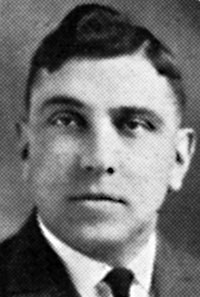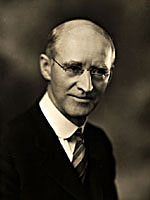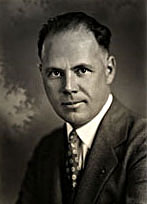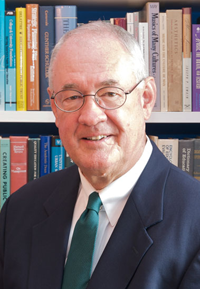Directors
 Appointed in May 1902, Leroy Anderson was instrumental in establishing the California Polytechnic as the first institution in the state to teach agriculture at the secondary level and the only institution other than the University of California where agriculture was taught.
Appointed in May 1902, Leroy Anderson was instrumental in establishing the California Polytechnic as the first institution in the state to teach agriculture at the secondary level and the only institution other than the University of California where agriculture was taught.
Born in Magee, New York in 1866, Anderson earned his PhD in 1897 at Cornell University. He taught there until 1900, when he came to California to join the agriculture faculty at the University of California. His recommendations for the Polytechnic School, submitted at the request of the board of trustees, resulted in his appointment as director in 1902.
Anderson recruited the first faculty. He oversaw the construction of the campus buildings and the equipping of the agricultural and mechanics units. Throughout his five years he was a vigorous promoter of the school, lobbying with the state legislature for support and recruiting students throughout the state.
Anderson resigned in January 1907 to return to the University of California as professor in Agricultural Practice and director of Farm Schools.
 In 1905, Leroy Burns Smith began his affiliation with Cal Poly as an instructor in English, history and economics. An energetic supporter of the school, he was named vice-director in June 1907 and upon the resignation of Leroy Anderson, became the school’s second director in January 1908.
In 1905, Leroy Burns Smith began his affiliation with Cal Poly as an instructor in English, history and economics. An energetic supporter of the school, he was named vice-director in June 1907 and upon the resignation of Leroy Anderson, became the school’s second director in January 1908.
Like his predecessor, Smith was a graduate of Cornell University (1901). He came to Cal Poly with educational and administrative experience in the Young Men’s Christian Association at the University of Wisconsin and in San Francisco.
As the director of the California Polytechnic, Smith continued the campus development and the educational plan begun by Anderson. Smith extended the academic program from three years of study to four, and introduced a series of agricultural and domestic extension courses for men and women on the local farms. At his encouragement and under his advisement, student organizations flourished, and Cal Poly’s Student Association, precursor to the ASI, was formed.
Smith resigned the directorship at Cal Poly in May 1914 to accept a position at the University of California.
 The appointment of Robert Weir Ryder as the third director of the Cal Poly School was, in a sense, an affirmation of the importance of the school’s engineering program. A graduate of the University of California, Ryder came to Cal Poly in 1911 as head of the Mechanics Department.
The appointment of Robert Weir Ryder as the third director of the Cal Poly School was, in a sense, an affirmation of the importance of the school’s engineering program. A graduate of the University of California, Ryder came to Cal Poly in 1911 as head of the Mechanics Department.
Ryder’s administration was marked with numerous innovations to the Cal Poly curriculum, including a college preparatory course, auto mechanics, and a printing course, which was a precursor to today’s journalism and graphic communications departments. With the introduction of an academic course, Cal Poly received accreditation by the University of California in 1917. A military training program was introduced at Cal Poly and after World War I, Cal Poly provided vocational training for disabled veterans.
Ryder resigned in 1921 to accept a commission with the U.S. Army Corps of Engineers.
Presidents
 Nicholas Ricciardi became director of the Cal Poly School on July 1, 1921. On July 30, 1921, an act of legislature restructured the state normal school and vocational school systems. Cal Poly’s local board of trustees was disbanded and Ricciardi, now “president,” reported to the state superintendent of public instruction.
Nicholas Ricciardi became director of the Cal Poly School on July 1, 1921. On July 30, 1921, an act of legislature restructured the state normal school and vocational school systems. Cal Poly’s local board of trustees was disbanded and Ricciardi, now “president,” reported to the state superintendent of public instruction.
A graduate of the University of California, President Ricciardi brought extensive experience in secondary and vocational education. He had served as director of vocational training for the Oakland school system and as head of the Twelfth District Board for Vocational Training of World War I veterans.
At Poly, Ricciardi emphasized “vocational efficiency and efficient citizenship” of students. He introduced vocational testing and guidance into Cal Poly’s educational mission. The Journalism and Graphics Communications departments originated during this period in the new “printing course.”
Ricciardi resigned from Cal Poly in January 1924 to become stat commissioner of vocational education.
 Margaret Chase, the only woman to head the California Polytechnic, joined its faculty in 1908 as instructor in English and served the institution in a variety of teaching and administrative capacities.
Margaret Chase, the only woman to head the California Polytechnic, joined its faculty in 1908 as instructor in English and served the institution in a variety of teaching and administrative capacities.
Born in Canada, Chase graduated from Dalhousie University and received her M.A. from the University of California. As head of the Academic Department, Chase was instrumental in attaining accreditation from the University of California during the Ryder administration. Having served as Ricciardi’s vice-president, Chase was the obvious choice for an interim executive upon his resignation. In a period of fiscal austerity and intense scrutiny of the school’s educational mission, Chase provided a sense of continuity and optimism for students and faculty.
With the appointment of President Benjamin Crandall, Chase resumed the post of vice president. She also continued as head of the Academic Department and in 1928, was made dean of the Junior College Division. Chase retired from Cal Poly in June 1945. Chase Hall is named in her honor.
 In Benjamin Crandall, Cal Poly acquired a well-respected educator with teaching and administrative experience at both the secondary and university level. He inherited a somewhat embattled Cal Poly and his tenure was one of constant re-evaluation, reorganization, expansion and retrenchment.
In Benjamin Crandall, Cal Poly acquired a well-respected educator with teaching and administrative experience at both the secondary and university level. He inherited a somewhat embattled Cal Poly and his tenure was one of constant re-evaluation, reorganization, expansion and retrenchment.
With degrees in pedagogy from the University of Wyoming and the University of Denver, and additional graduate training at Cornell and the University of California, Crandall served as superintendent of schools in several western cities prior to becoming a professor of agricultural education at the University of California in 1921. In 1924, he was urged by the State Board of Education and the governor to accept the presidency of Cal Poly.
In 1926, the project system, predecessor of the senior projects, was applied in agricultural courses. In 1927, the opening of the two-year Junior College Division foreshadowed Cal Poly’s evolution into a university, and a new aeronautics program was added to the Engineering Department.
In 1929, as part of a reorganization of the school, enrollment was limited to male students, and by 1933, the college preparatory course was eliminated. The Polytechnic became a vocational institute open only to students over the age of eighteen.
Crandall resigned the presidency of Cal Poly in 1933.
 A graduate of the University of California, obtaining a B.S. in 1917 and a masters degree in 1928, Julian McPhee first gained experience in agricultural education in the U.C. Agriculture Extension Service and as director of vocational agriculture at El Dorado County High School and Gilroy Union High School.
A graduate of the University of California, obtaining a B.S. in 1917 and a masters degree in 1928, Julian McPhee first gained experience in agricultural education in the U.C. Agriculture Extension Service and as director of vocational agriculture at El Dorado County High School and Gilroy Union High School.
McPhee’s influence in the State Bureau of Agricultural Education helped save the flagging school from being closed by the state. McPhee was instrumental in the reorganization of Cal Poly into a single-sex institute for men over the age of 18. In 1933, McPhee was appointed president of the California Polytechnic and served concurrently as chief of the Bureau of Agricultural Education, California State Department of Education. Then a two-year technical institute, Cal Poly, under President McPhee’s leadership, evolved into a four-year college in the California State College system.
During WWII, McPhee served as director of California’s War Food Production Training Program. He later served as acting chief of the Bureau of Readjustment Education, assistant executive officer of the State Board of Vocational Education, and director of Vocational Education for the State of California. He was awarded the LL.D. by Armstrong College in 1952.
In 1966, after thirty-three years as president of Cal Poly, Julian A. McPhee retired.
 Dale W. Andrews received his B.A. from the University of California, Davis in 1941 and his M.A. in agricultural education at Cal Poly in 1952.
Dale W. Andrews received his B.A. from the University of California, Davis in 1941 and his M.A. in agricultural education at Cal Poly in 1952.
Andrews joined the Cal Poly faculty in 1950 as an instructor in agricultural education. He is credited with establishing the annual Poly Royal buttons.
In 1960, Andrews was named Special Educational Services coordinator by President Julian McPhee. In 1966, he was appointed vice-president and then acting president when President McPhee retired. He was named executive vice-president in 1973. In 1979, he was once again named acting president following the retirement of President Robert E. Kennedy.
 Robert E. Kennedy received his B.A. from San Diego State College in 1938, his M.A. in journalism from Stanford University in 1950, and his Ph.D. in education administration from Claremont Graduate School in 1966.
Robert E. Kennedy received his B.A. from San Diego State College in 1938, his M.A. in journalism from Stanford University in 1950, and his Ph.D. in education administration from Claremont Graduate School in 1966.
Kennedy joined the Cal Poly faculty in 1940 as a journalism instructor. He served as advisor to student publications, and during WWII, with the arrival of U.S. Naval training programs on the Cal Poly campus, instructed cadets in communications.
In 1946, Kennedy became head of the Journalism Dept., to which title he added public relations director in 1949. He was assistant to President Julian McPhee from 1950 to 1957; dean of the Arts and Sciences Division from 1957 to 1959; and vice president of Cal Poly from 1959 to 1967. Following the retirement of President McPhee, Kennedy was appointed president. In 1972, under President Kennedy’s leadership, California Polytechnic State College was officially designated California Polytechnic State University.
During his long tenure as faculty and administrator at Cal Poly, Robert Kennedy represented the college on numerous state and national education councils, including the Chancellor’s Council of Presidents and the American Association of State Colleges and Universities (AASCU). For the AASCU he served as a member of the board of directors, a representative to the Education Commission of the States and a member of AASCU committees on agriculture, public relations, and state relations.
In 1978, in honor of his long and dedicated service to Cal Poly, the CSUC Trustees voted to name the new Cal Poly library “The Robert E. Kennedy Library.” Kennedy retired from the presidency at Cal Poly in 1979.
 Warren J. Baker served as Cal Poly’s president from 1979 through 2010. A civil engineer registered to practice in four states, Baker is a recognized leader in higher education and he served Cal Poly for 31 years.
Warren J. Baker served as Cal Poly’s president from 1979 through 2010. A civil engineer registered to practice in four states, Baker is a recognized leader in higher education and he served Cal Poly for 31 years.
For more information about Baker’s career, read an in-depth article published by Cal Poly Magazine in 2010.
 Robert Glidden served as Cal Poly’s interim president. A native of Iowa, Dr. Glidden earned all of his academic degrees in music from the University of Iowa, a B.A. in 1958, the M.A. in 1960, and the Ph.D. in 1966. He is president emeritus of Ohio University, a public research-extensive institution with 20,000 students in Athens and an additional 9,000 students on five regional campuses throughout southeast Ohio.
Robert Glidden served as Cal Poly’s interim president. A native of Iowa, Dr. Glidden earned all of his academic degrees in music from the University of Iowa, a B.A. in 1958, the M.A. in 1960, and the Ph.D. in 1966. He is president emeritus of Ohio University, a public research-extensive institution with 20,000 students in Athens and an additional 9,000 students on five regional campuses throughout southeast Ohio.
 Jeffrey D. Armstrong currently serves as Cal Poly’s president.
Jeffrey D. Armstrong currently serves as Cal Poly’s president.
President Armstrong received his bachelor’s degree in agriculture from Murray State University. He received both his master’s and doctorate in physiology and endocrinology from NCSU.
Armstrong joined the Cal Poly campus in 2011 after tenure at NCSU (faculty), Purdue University (head of the Department of Animal Sciences) and Michigan State University (dean of the College of Agriculture and Natural Resources).
For an in-depth biography, please see Cal Poly’s Office of the President web site.